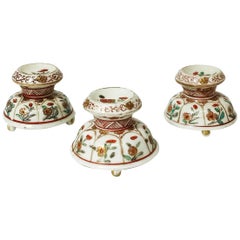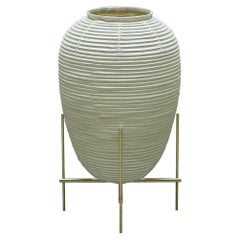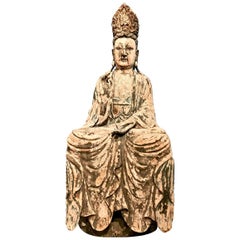17th Century Antiquities
Period: 17th Century
Color: Beige
Japanese Arita, Amsterdams Bont, Tripod Salt Cellars, 1690-1730
Located in Delft, NL
Japanese Arita, Amsterdams Bont, tripod salt cellars, 1690-1730
European decoration on Japanese porcelain.
"Arita" porcelain made in Japan, during ...
Category
Japanese Antique 17th Century Antiquities
Materials
Porcelain
Related Items
Contemporary Japanese Chochin Floor Lamp Zen Washi Japanese Paper Shade
Located in Shibuya-ku, Tokyo
Name: Under the Hazy Moon
Contemporary style Japanese Washi Japanese traditional paper shade floor lamp. Washi shade is famous as Isamu Noguchi Akari lightings.
Base is made of brass...
Category
Japanese Edo 17th Century Antiquities
Materials
Brass
H 30.32 in W 18.12 in D 18.12 in
Blue and White Saucer, Qing Dynasty, Kangxi Era, Circa 1690
Located in seoul, KR
It features a complex design with a central circular motif surrounded by eight petal-like sections, each intricately adorned with various botanical and geometric patterns, creating a symmetrical arrangement.
The number 8 in Chinese culture is associated with prosperity and is considered very auspicious. This may reflect the traditional Chinese cosmological concept of the "Bagua," which are eight trigrams used in Taoist philosophy to represent fundamental principles of reality, seen in various aspects of Chinese culture, including the I Ching and Feng Shui.
The central circle with radiating petals is also a representation of perfect geometric harmony, reflecting the balance and unity which are key elements in Chinese aesthetics. The use of symmetry and balance is seen as a way to represent the harmony of the universe.
Period : Qing Dynasty, Kangxi Period
Production Date : 1690-1699
Made in : Jingdezhen
Destination : Netherland
Found/Acquired : Southeast Asia , South China Sea, Vung Tau ship
Size : 12.5cm (Diameter)
Condition : Excellent
Reference : Double checked with reference to the original catalogues
1) Christies Amsterdam 1992 - Vung Tau Cargo / Christies
2) Qing Dynasty Export Blue and White(淸代外销靑花瓷) - Vung Tau Cargo Catalogue / Guangxi Fine Art Publishing House
3) Asian Ceramic Found along Maritime Silk Route / National Maritime Museum of Korea
* Vung Tau Cargo Porcelain...
Category
Chinese Qing Antique 17th Century Antiquities
Materials
Ceramic
Japanese Antique Wooden Object
Located in Sammu-shi, Chiba
An old tool for making textiles in Japan.
It's a very rare object.
The light and shadow that pass through the even holes are very beautiful.
A nice art ob...
Category
Asian Meiji Antique 17th Century Antiquities
Materials
Oak
Antique Bronze Vase Cloisonné Japan Meiji 19th Century Japanese
Located in Amsterdam, Noord Holland
Absolute top Quality vase with superb decoration of flowers
Cloisonné is a way of enamelling an object, (typically made of copper) whereby fine wires are used to delineate the dec...
Category
Japanese Meiji Antique 17th Century Antiquities
Materials
Porcelain
Blue and White Baluster Vase, Qing Dynasty, Kangxi Era, Circa 1690
Located in seoul, KR
The baluster shaped vase rising from a splayed foot to a short waisted neck, decorated in underglaze blue with flower blooms borne on leafy stems.
Period : Qing Dynasty, Kangxi reign
Production Date : 1690-1699
Made in : Jingdezhen
Destination : Amsterdam
Found/Acquired : Southeast Asia , South China Sea, Vung Tau...
Category
Chinese Chinoiserie Antique 17th Century Antiquities
Materials
Ceramic
Carved 'Longquan' Celadon-Glazed Tripod Censer, Ming dynasty
Located in seoul, KR
This censer is characterized by its tripod form, which means it stands on three feet. Incense burners from the Ming dynasty are often highly regarded for their craftsmanship and the quality of the glaze texture and coloration. This piece features finely carved patterns that likely draw inspiration from traditional Chinese motifs. Such items were commonly used for burning incense and sometimes served as significant decorative pieces in ceremonial spaces or the homes of the elite.
Period: Ming Dynasty (1368~1644)
Region: Longquan, China
Medium: Stoneware - Celadon glazed
Type: Tripod censer
Size : 24.2 cm(Diameter) , 10.8cm(Height)
Provenance : Acquired in 1999, Hongkong
Reference : Sotheby's Newyork 26 September 2023 - CHINA / 5000 YEARS - Lot1135
* Ming Dynasty Longquan Celadon
Longquan celadon from the Ming Dynasty typically exhibits a more robust and heavier stoneware body compared to its Song Dynasty predecessors. The Ming era saw an evolution in celadon glaze, achieving a wider spectrum of green hues, from olive to bluish-greens. Ming celadons...
Category
Chinese Ming Antique 17th Century Antiquities
Materials
Celadon
Mid-size Octagonal Saucer, Qing Dynasty, Kangxi era, circa 1690.
Located in seoul, KR
The design features a central medallion surrounded by eight panels, each intricately painted with traditional Chinese botanical and floral motifs.
The number 8 in Chinese culture is associated with prosperity and is considered very auspicious. This may reflect the traditional Chinese cosmological concept of the "Bagua," which are eight trigrams used in Taoist philosophy to represent fundamental principles of reality, seen in various aspects of Chinese culture, including the I Ching and Feng Shui.
The central circle with radiating petals is also a representation of perfect geometric harmony, reflecting the balance and unity which are key elements in Chinese aesthetics. The use of symmetry and balance is seen as a way to represent the harmony of the universe.
Period : Qing Dynasty, Kangxi Period
Production Date : 1690-1699
Made in : Jingdezhen
Destination : Netherland
Found/Acquired : Southeast Asia , South China Sea, Vung Tau...
Category
Chinese Qing Antique 17th Century Antiquities
Materials
Ceramic
Kendi Blue And White, Qing Dynasty, Kangxi Period, C 1690
Located in seoul, KR
The Kendi is decorated with cobalt blue underglaze depicting flowers and a mythical bird, reflecting the artistic finesse and symbolic expressions of the era. These designs often carry symbolic meanings, with birds sometimes representing immortality or spiritual transcendence in Chinese mythology. The Kendi's form, with a bulbous body and spout for drinking, is a traditional vessel style in Asia, valued for both its functionality and aesthetic appeal.
Period : Qing Dynasty, Kangxi Period
Production Date : 1690-1699
Made in : Jingdezhen
Destination : Netherland
Found/Acquired : Southeast Asia , South China Sea, Vung Tau ship
Reference : Double checked with reference to the original catalogues
1) Christies Amsterdam 1992 - Vung Tau Cargo / Christies
2) Qing Dynasty Export...
Category
Chinese Qing Antique 17th Century Antiquities
Materials
Ceramic
Green-Glazed Tripod Vessel, Han Dynasty
Located in seoul, KR
Han Dynasty green-glazed tripods are comparatively rare, especially ones that have retained their structural integrity and glaze over millennia. Pieces in good condition are scarce b...
Category
Chinese Han Antique 17th Century Antiquities
Materials
Earthenware
Blue And White Vase, Qing Dynasty, Kangxi Era, Circa 1690
Located in seoul, KR
The painting features a typical Kangxi blue and white style depiction of a female figure.
Period : Qing Dynasty, Kangxi reign
Production Date : 1690-1699
Made in : Jingdezhen
Destination : Amsterdam
Found/Acquired : Southeast Asia , South China Sea, Vung Tau Ship
Reference : Double checked with reference to the original catalogues
1) Christies Amsterdam 1992 - Vung Tau Cargo...
Category
Chinese Qing Antique 17th Century Antiquities
Materials
Ceramic
Japanese Porcelain Plate, Japan, End of the 19th Century
Located in Roma, IT
You are admiring a refined Japanese Porcelain plate made by Japan manufacture during the end of the 19th century.
This elegant decorative ...
Category
Japanese Antique 17th Century Antiquities
Materials
Porcelain
Ancient Gu Shape 'Canal Houses' Vase, Qing Dynasty, Kangxi Era, Circa 1690
Located in seoul, KR
This vase is decorated with dutch canal houses on one side and Chinese pagodas and flowers on the other side. Eastern and Western motifs were simultaneously expressed in ceramics.
Period : Qing Dynasty, Kangxi Period
Production Date : 1690-1699
Made in : Jingdezhen
Destination : Netherland
Found/Acquired : Southeast Asia , South China Sea, Vung Tau...
Category
Chinese Chinoiserie Antique 17th Century Antiquities
Materials
Ceramic
No Reserve
H 10.63 in Dm 5.52 in
Previously Available Items
17th - 18th Century, Shan, Antique Burmese Alabaster Marble Seated Buddha Statue
Located in Sampantawong, TH
Antique Burmese alabaster Buddha sitting in Mara Vijaya (calling the earth to witness) posture on a base.
Age: Burma, Shan Period, 17th - 18th Century
Size: Height 55 C.M. / Width 3...
Category
Burmese Antique 17th Century Antiquities
Materials
Alabaster
H 21.66 in W 12.6 in D 7.29 in
17th-18th Century Japanese Large Carved Wood Quan Yin
Located in Pasadena, CA
This is a beautifully executed large late 17th-early 18th century Edo period Japanese temple figure of a Buddhistic Quan Yin that dates to the late 17th century the figure retains it...
Category
Japanese Edo Antique 17th Century Antiquities
Materials
Paint
Recently Viewed
View AllMore Ways To Browse
Greco Bactrian
Desert Samurai
Chinese Opium Pipes
Samurai Hat
19th Century Burmese Thai Buddha
Used Polo Boots
Antique Chinese Corbels
Khmer Goddess
Horse Hair Ceramic Art
Pottery Chinese Immortals
Opium Lamp
Antique Pig Figurine
Antique Pig Figurines
The Battle For Hermes
Antique Chinese Coconut
Antique Asian Porcelain Dolls
Asian Lady Figurine
Northern Qi Buddha




